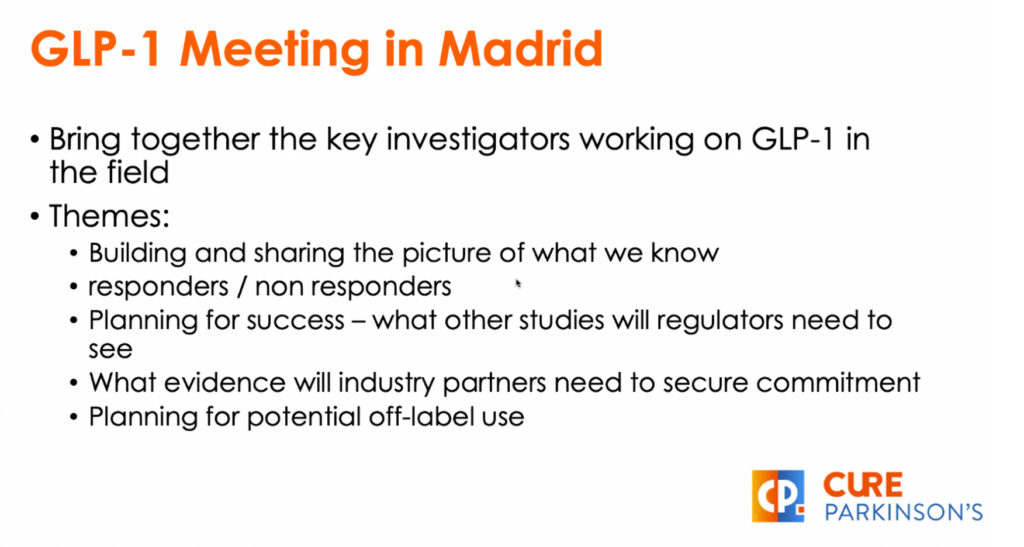This was a hybrid meeting with participants meeting in-person as well as participating via a live-stream. The hybrid format had some initial hiccups with sound issues, but it worked well overall and allowed participants from across the country – including myself – to attend this interesting event!
The meeting started with a welcome from Dr Richard Wyse who gave background information about the topic and an overview of the timeline of how the link between Parkinson’s disease (PD) and diabetes was unravelled.
Dr Alastair Noyce from Queen Mary University of London, UK then presented evidence for the association between type 2 diabetes (T2DM) and Parkinson’s risk/severity. Dr Noyce presented us with intriguing data from a number of laboratories including his own, which showed a clear epidemiological link between Parkinson’s Disease and T2DM with the risk of Parkinson’s Disease increasing the longer an individual has type 2 diabetes. In addition, patients with Parkinson’s Disease who also have diabetes have a worse phenotype with worse motor and cognitive symptoms and more aggressive progression. He then described an ongoing study assessing blood biomarkers in patients with Parkinson’s Disease with and without T2DM, again showing higher levels of blood biomarkers of axonal damage such as neurofilament levels in patients with diabetes compared to patients with Parkinson’s Disease without diabetes; this effect was even more pronounced in patients with uncontrolled diabetes. Dr Noyce discussed causality and the need for further research but planted the seed to the audience that we could potentially prevent or treat Parkinson’s Disease by treating T2DM.
Professor Michele Tagliati from Cedars Sinai, US talked about the potential use of liraglutide, an antidiabetic medication in the treatment of Parkinson’s. He discussed the results of a randomised controlled study assessing cognitive, motor and non-motor symptoms in patients with Parkinson’s Disease treated with liraglutide versus a placebo. After 1 year there was no significant difference in cognitive or motor performance but there was a significant improvement in non-motor scores (across all symptom domains) in patients treated with liraglutide. Secondary outcomes including the global Movement Disorder Society Unified Parkinson’s Disease Rating Scale (MDS-UPDRS) scores, activities of daily living and quality of life measures also showed improvement in patients after one year of being treated with liraglutide. Overall, although still early days, his talk highlighted liraglutide as a potential emerging therapeutic in Parkinson’s Disease.
After a short break, Dr Dilan Athauda from University College London, UK, discussed the use of another diabetic medication, exenatide, for the treatment of Parkinson’s Disease. He provided compelling evidence that exenatide does have potential as a treatment for Parkinson’s disease. Perhaps even more exciting was his suggestion that early recent evidence from animal models of Parkinson’s suggest that dual GLP1 agonists may be even more effective than exenatide in preventing neuronal loss. He finished by discussing his plans for research using human induced pluripotent stem cells to model Parkinson’s disease and to trial these dual agonists in the lab to evaluate different agonists to decide which should be taken to clinical trials.
The day finished with an overview of the multitude of clinical trials examining GLP-1 agonists in the treatment of Parkinson’s Disease by Dr Selen Yalkic; with more than 8 studies currently underway around the world with results in the coming months and years, it will surely be an interesting and evolving research area! This is why a specific GLP-1 meeting is planned in Madrid to bring together the key investigators working in the field and to plan for a regulatory process and potential off-label use.
After a Q&A session, the day came to an end on a rather hopeful note, knowing the potential that antidiabetic medications could play in the future in Parkinson’s disease. Individuals living with Parkinson’s disease and all health professionals involved in their care will surely be waiting impatiently to see the results of the various clinical trials!

You can watch the presentations, and the recordings of the key speakers.

